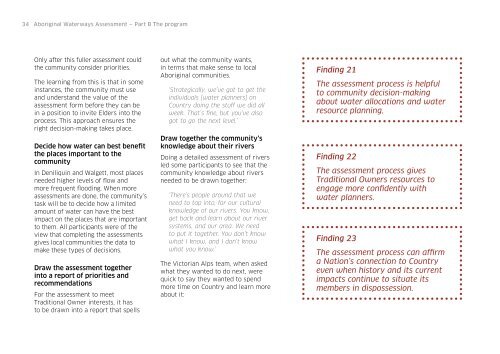Aboriginal Waterways Assessment program
dCckIF
dCckIF
Create successful ePaper yourself
Turn your PDF publications into a flip-book with our unique Google optimized e-Paper software.
34 <strong>Aboriginal</strong> <strong>Waterways</strong> <strong>Assessment</strong> — Part B The <strong>program</strong><br />
Only after this fuller assessment could<br />
the community consider priorities.<br />
The learning from this is that in some<br />
instances, the community must use<br />
and understand the value of the<br />
assessment form before they can be<br />
in a position to invite Elders into the<br />
process. This approach ensures the<br />
right decision-making takes place.<br />
Decide how water can best benefit<br />
the places important to the<br />
community<br />
In Deniliquin and Walgett, most places<br />
needed higher levels of flow and<br />
more frequent flooding. When more<br />
assessments are done, the community’s<br />
task will be to decide how a limited<br />
amount of water can have the best<br />
impact on the places that are important<br />
to them. All participants were of the<br />
view that completing the assessments<br />
gives local communities the data to<br />
make these types of decisions.<br />
Draw the assessment together<br />
into a report of priorities and<br />
recommendations<br />
For the assessment to meet<br />
Traditional Owner interests, it has<br />
to be drawn into a report that spells<br />
out what the community wants,<br />
in terms that make sense to local<br />
<strong>Aboriginal</strong> communities.<br />
‘Strategically, we’ve got to get the<br />
individuals [water planners] on<br />
Country doing the stuff we did all<br />
week. That’s fine, but you’ve also<br />
got to go the next level.’<br />
Draw together the community’s<br />
knowledge about their rivers<br />
Doing a detailed assessment of rivers<br />
led some participants to see that the<br />
community knowledge about rivers<br />
needed to be drawn together:<br />
‘There’s people around that we<br />
need to tap into, for our cultural<br />
knowledge of our rivers. You know,<br />
get back and learn about our river<br />
systems, and our area. We need<br />
to put it together. You don’t know<br />
what I know, and I don’t know<br />
what you know.’<br />
The Victorian Alps team, when asked<br />
what they wanted to do next, were<br />
quick to say they wanted to spend<br />
more time on Country and learn more<br />
about it:<br />
Finding 21<br />
The assessment process is helpful<br />
to community decision-making<br />
about water allocations and water<br />
resource planning.<br />
Finding 22<br />
The assessment process gives<br />
Traditional Owners resources to<br />
engage more confidently with<br />
water planners.<br />
Finding 23<br />
The assessment process can affirm<br />
a Nation’s connection to Country<br />
even when history and its current<br />
impacts continue to situate its<br />
members in dispossession.


